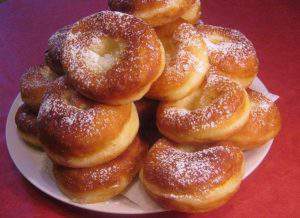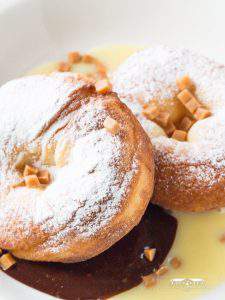Recipe of the week: carnival doughnut

To ring in the carnival season in Hungary and the Busójárás of Mohács we thought that we would share the story and recipe of the most traditional carnival meal: the carnival doughnut (farsangi fánk). We can guarantee that this decadent dessert will top off your carnival celebrations, festivities.
Doughnuts are popular desserts, snacks all over the world, and are believed to have been cultic meals in several ancient religions. According to fusz.hu, there are two famous legends about how the doughnut spread in Europe.
One of the legends is centred around the French beignets dessert, which Queen Marie Antoinette came to know during an adventurous carnival night. The queen escaped from the masquerade held in the Tuileries Palace and mingled with the crowd on the streets.
She got hungry after a while, so she bought a doughnut from a gingerbread master. She very much liked the doughnut, so the cavalier accompanying her had to buy a whole basket. After the carnival, she ordered the baker to the palace, who then told the recipe and directions to the confectioner of the queen. The confectioner modified the recipe here and there, but from that moment on, the doughnut became a beloved dessert of royal dinners.
Since it was very delicious, filling and cheap, the fame of the doughnut spread quite quickly among people.

Based on the other legend, the European doughnut was born in Vienna. According to the rumours, there was a baker called Krapfen living in the city. After his death, his widow took over the bakery. She had a tough life, but still, her bread was the best in Vienna.
There was a day when the daily bread portion was not ready in time, so the customers waited impatiently or left while cursing the bakery. After a while, Mrs Krapfen lost her temper too and wanted to throw a piece of dough at someone’s head. But she missed the target, and the dough ended up in a pan filled with fat. The dough turned golden brown in a few minutes, and this is how the first doughnut was born.
It’s up to you whether or not you believe these legends 🙂
However, it is almost 100% sure that doughnuts spread widely in Hungary in the 19th century. According to a memoir, doughnuts were already served as the seventh dish at the feast of Count Szaniszló Thurzó in the castle of Galgóc in 1603.
The tradition of baking doughnuts first spread in Transdanubia region. It slowly became an essential part of the carnival season between Epiphany and Ash Wednesday.

According to zilakavehaz.hu, the carnival doughnut is usually made from an eggy dough, but it has several other versions as well (e.g. made with potatoes or the cruller type). It can be created with or without a filling, salty or sweet. The most important characteristic is that it must be baked in a lot of fat or oil.
Several superstitions are connected to the doughnut. The carnival season used to be the period of finding love. Girls gave doughnuts to the desired boy, while the boys called the girls “little doughnut”. If a couple tore a doughnut together, it was inevitable that they were going to get married soon because the ribbon going around the doughnut symbolised the wedding ring.
After recapping the history of the carnival doughnut, we would like to share with you the recipe of the traditional Hungarian version – taken over from nosalty.hu.
Photo: www.nosalty.huIngredients (for 12 big doughnuts):
- 500 grams of flour
- 25 grams of yeast
- 1 tablespoon of sugar
- 1 tablespoon of rum
- 5 dl of milk
- 1 egg
- 750 grams of fat (for baking)
Directions:
Heat up one decilitre of milk until it reaches a lukewarm temperature. Stir in the sugar and the yeast. After it has risen, add the mixture to the flour. Add the leftover milk, egg and the rum. Start mixing it with a wooden spoon and keep on working it for ten minutes or so until you get a soft, blebby dough. Sprinkle the top with some flour, cover it and let it raise in a warm spot for around an hour.
After the dough has doubled in size, roll it out to a thickness of 2-3 centimetres and cut out round shapes. Let them raise again for 30 minutes in a warm place. Then, heat up the fat and slowly add the doughnuts upside down (starting with the side that was on the rolling board). Turn them over 2-3 minutes later (if your pan is deep enough, they might even turn around by themselves after just touching them). You’re looking fun golden brown, crispy doughnuts. Blot them a bit and serve the doughnuts while still hot. Sprinkle with some powdered sugar and add some jam if you’d like to 🙂
Enjoy!
Featured image: www.zilakavehaz.hu
Source: Daily News Hungary





